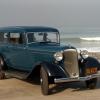Depends on year and car.
For Plymouth the oil filter was standard in 1933 but later became standard on DeLuxe models only. For the Standard 6, Roadking, etc. it was an option.
If installed, it is a canister on a bracket on the driver side of the block between the distributor and the starter (actually above both of those and pretty much above the head). It is a by-pass filter and could be either a sealed canister (no longer available new but ePay has them come up all the time). Or it was a housing that took a replaceable element. Which element you need depends on what canister you have. The oil filter is plumbed from the oil pressure relief valve and is setup so the flow through the filter is dependent on the oil pressure in the block (except on early 1933 model engines where the oil pressure relief valve is either on the oil pump or inside the oil pan depending on engine number).
If you have a later "big block" engine (DeSoto, Chrysler, large Dodge truck or Canadian built vechicle) then it may have been equipped with a full flow filter which was a canister assembly that bolted on the block and took a refill cartridge.


